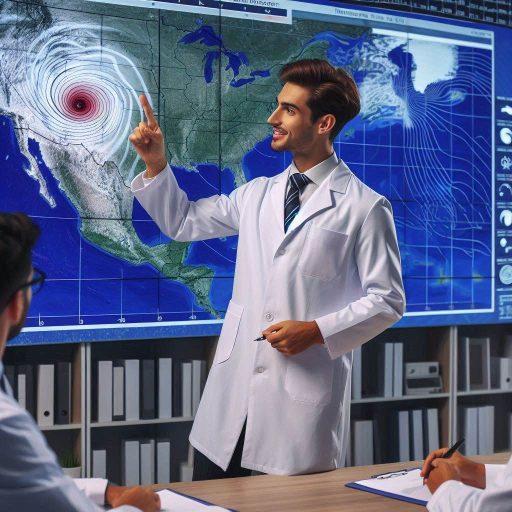Introduction
Meteorologists are scientists who study the atmosphere and weather patterns to understand and predict atmospheric phenomena.
They analyze data from satellites, weather stations, and radar to generate accurate forecasts.
Their work is essential for various sectors, including agriculture, transportation, and emergency management.
Disaster preparedness involves planning and preparing for potential emergencies, ensuring that individuals and communities can respond effectively to natural disasters.
The importance of disaster preparedness cannot be overstated; it saves lives, reduces economic losses, and helps communities recover more quickly after disasters strike.
Meteorologists play a pivotal role in disaster preparedness by providing timely and accurate weather forecasts and warnings.
They monitor and analyze weather conditions to anticipate severe events such as hurricanes, tornadoes, and floods.
By disseminating this information, meteorologists empower communities to take proactive measures to protect themselves and their property.
Their expertise in understanding complex weather systems helps inform emergency response strategies, making them invaluable in mitigating the impacts of disasters.
Forecasting and Monitoring Natural Disasters
Meteorologists play a vital role in disaster preparedness by forecasting and monitoring natural disasters.
They utilize advanced technology to predict severe weather events accurately.
This technology includes satellite imagery, radar systems, and computer modeling.
These tools help meteorologists analyze weather patterns and anticipate changes in real time.
Utilization of Technology in Predicting Severe Weather Events
The integration of technology enhances the accuracy of weather predictions.
For instance, Doppler radar provides real-time data on storm development and movement.
Meteorologists can track storms, assess their intensity, and predict their paths.
This information is crucial for timely interventions.
Additionally, weather modeling software simulates various weather scenarios, helping meteorologists prepare for potential disasters.
Monitoring Weather Patterns and Changes
Meteorologists continuously monitor weather conditions across vast areas.
They assess factors like temperature, humidity, and wind speed.
This data allows them to identify potential threats, such as storms, hurricanes, or floods.
By analyzing historical data, they recognize patterns that may indicate future disasters.
Satellites also play a significant role in monitoring large weather systems.
They capture images of cloud formations and track atmospheric changes, which helps in predicting the intensity and path of severe weather events.
Issuing Warnings and Alerts to the Public
When meteorologists issue warnings and alerts, they rely on clear communication.
They provide detailed information about the nature of the threat and recommended actions.
This communication can save lives by ensuring people know how to respond.
Meteorologists often use multiple platforms, including television, radio, and social media, to reach a broad audience.
The faster the public receives alerts, the more time they have to prepare.
Effective communication during crises can greatly reduce panic and confusion, allowing communities to take necessary precautions.
In summary, meteorologists play an essential role in disaster preparedness through forecasting and monitoring.
They utilize technology to predict severe weather events accurately, monitor weather patterns and changes, and issue timely warnings to the public.
Their expertise and dedication help communities better prepare for and respond to natural disasters, ultimately saving lives and minimizing damage.
Collaborating with Disaster Management Agencies
Meteorologists play a critical role in disaster preparedness by collaborating with disaster management agencies.
This collaboration enhances the effectiveness of emergency response efforts.
By working together, meteorologists and disaster management professionals can develop comprehensive strategies for addressing natural disasters.
Sharing Data and Information with Emergency Response Teams
Meteorologists share vital data and information with emergency response teams.
This information includes weather forecasts, severe weather alerts, and real-time updates.
By providing accurate and timely data, meteorologists help responders make informed decisions.
This collaboration ensures that emergency teams are prepared for potential disasters and can mobilize resources effectively.
Guidance on Evacuations and Emergency Response Plans
Meteorologists also provide crucial guidance on evacuations and emergency response plans.
They analyze weather conditions and advise disaster management agencies on when and where to evacuate populations.
This guidance is essential for ensuring public safety during severe weather events.
Additionally, meteorologists help develop response plans tailored to specific disasters, such as hurricanes, floods, or wildfires.
Working Together to Minimize the Impact of Disasters
By working together, meteorologists and disaster management agencies can minimize the impact of disasters.
Their collaborative efforts enhance preparedness and response capabilities.
This teamwork enables communities to react quickly and effectively when disasters occur.
It also fosters public trust in emergency management efforts, encouraging residents to heed warnings and follow safety protocols.
The collaboration between meteorologists and disaster management agencies is vital for disaster preparedness.
By sharing data and information, providing guidance on evacuations, and working together to minimize disaster impacts, they create a safer environment for communities.
Their combined efforts ultimately save lives and protect property during natural disasters.
Read: Top Skills Needed for a Successful Geology Career
Conducting Research and Analysis
Meteorologists play a crucial role in disaster preparedness by conducting research and analysis.
This ongoing effort enhances their understanding of weather phenomena and improves strategies for disaster response.
By studying past disasters, meteorologists can identify key factors that contribute to severe weather events.
Studying Past Disasters to Improve Preparedness Strategies
Analyzing historical data is essential for improving preparedness strategies.
Meteorologists examine previous disasters to understand their impacts and effectiveness of response measures.
This analysis helps identify strengths and weaknesses in current disaster management practices.
By learning from past events, meteorologists can recommend changes that enhance future preparedness efforts.
Analyzing Trends in Weather Patterns
Meteorologists also analyze trends in weather patterns to gain insights into potential future disasters.
They study long-term climate data to identify shifts in temperature, precipitation, and storm frequency.
This analysis helps them recognize emerging patterns that may indicate an increase in severe weather events.
Understanding these trends is vital for proactive disaster preparedness and response planning.
Developing Models to Predict Future Disasters
Meteorologists develop models to predict future disasters based on their research and analysis.
These models simulate various weather scenarios, allowing meteorologists to assess potential risks.
By incorporating data from past disasters and current weather patterns, they can create accurate predictions.
This predictive capability is essential for issuing timely warnings and implementing effective response measures.
The research and analysis conducted by meteorologists significantly enhance disaster preparedness.
By studying past disasters, analyzing weather trends, and developing predictive models, they improve strategies for managing severe weather events.
Their efforts contribute to more effective responses and ultimately help save lives and protect communities from the impacts of natural disasters.
Read: The Future of Botany: Emerging Fields and Innovations
Educating the Public
Meteorologists play a vital role in disaster preparedness by educating the public about severe weather events.
Their expertise helps communities understand the risks associated with natural disasters.
Through various initiatives, they promote awareness and empower individuals to take action in emergencies.
Hosting Educational Programs and Workshops
Meteorologists frequently host educational programs and workshops to inform the public.
These sessions cover topics such as storm safety, flood preparedness, and emergency response.
By providing accessible information, they equip communities with the knowledge needed to navigate severe weather situations.
These programs often include interactive elements, making learning engaging and impactful.
Raising Awareness About Disaster Preparedness
Raising awareness about disaster preparedness is essential for building resilient communities.
Meteorologists collaborate with local organizations and agencies to disseminate crucial information.
They utilize social media, public service announcements, and community events to reach a broader audience.
This proactive approach ensures that people are informed about potential risks and the importance of preparedness.
Teaching Individuals How to Respond in Emergencies
Meteorologists also focus on teaching individuals how to respond during emergencies.
They provide guidance on creating emergency plans, assembling disaster kits, and identifying safe shelters.
By empowering individuals with practical skills, they enhance community resilience.
This knowledge helps people react calmly and effectively during crises, reducing panic and confusion.
Educating the public is a key responsibility of meteorologists in disaster preparedness.
By hosting educational programs, raising awareness, and teaching emergency response techniques, they contribute to safer communities.
Their efforts ensure that individuals are prepared to face natural disasters with confidence and knowledge, ultimately saving lives and minimizing damage.
Read: What Does a Geologist Do? Career Overview and Insights
Transform Your Career Today
Unlock a personalized career strategy that drives real results. Get tailored advice and a roadmap designed just for you.
Start Now
Uncover the Details: Ethical Dilemmas in Nuclear Science
Training and Professional Development
Meteorologists play a crucial role in disaster preparedness by engaging in continuous training and professional development.
This commitment to learning ensures they stay current with the latest advancements in meteorology.
Ongoing training enhances their skills and improves their ability to respond effectively during emergencies.
Continuously Updating Skills and Knowledge in Meteorology
Meteorologists must continuously update their skills and knowledge to adapt to evolving weather patterns and technologies.
They participate in workshops, seminars, and online courses focused on the latest research and methods.
This ongoing education ensures they remain experts in their field and can provide accurate forecasts and timely warnings.
Participating in Drills and Exercises to Improve Response Capabilities
Participation in drills and exercises is essential for meteorologists to improve their response capabilities.
These simulations allow them to practice emergency procedures and refine their skills in real-time scenarios.
By participating in coordinated drills with disaster management agencies, they learn how to work effectively as part of a team during crises.
Collaborating with Other Professionals in the Field
Collaboration with other professionals in the field enhances the effectiveness of meteorologists in disaster preparedness.
They work alongside emergency responders, climatologists, and public safety officials to share insights and develop comprehensive strategies.
This teamwork fosters a holistic approach to disaster management, ensuring that all aspects of preparedness are considered.
Training and professional development are essential for meteorologists in disaster preparedness.
By continuously updating their skills, participating in drills, and collaborating with other professionals, they enhance their ability to respond effectively to natural disasters.
Their commitment to ongoing learning ultimately contributes to safer communities and more resilient disaster management practices.
Read: Educational Path: Becoming a Geologist in the USA
Discover More: How Meteorologists Use Satellite and Radar Technology
Learn More: Microbiology Career Paths and Specializations
Response and Recovery Efforts
Meteorologists play a vital role in disaster response and recovery efforts.
Their expertise is essential not only during emergencies but also in the aftermath of disasters.
They assist communities in navigating the challenges that arise after a natural disaster strikes.
Assisting in the Aftermath of Disasters
After a disaster, meteorologists provide crucial support to affected areas.
They help emergency responders and recovery teams understand current weather conditions.
This information is vital for planning and coordinating recovery efforts.
By assessing ongoing weather threats, meteorologists ensure that recovery operations proceed safely and efficiently.
Conducting Damage Assessments
Meteorologists conduct damage assessments to evaluate the impact of disasters.
They analyze data from satellite imagery, aerial surveys, and ground reports.
This analysis helps identify areas most affected by severe weather.
Understanding the extent of the damage is crucial for resource allocation and recovery planning.
Providing Support to Communities During Recovery
Meteorologists also provide support to communities during the recovery phase.
They offer guidance on rebuilding efforts, considering future weather risks.
By sharing expertise on local weather patterns, meteorologists help communities make informed decisions.
This support includes advising on infrastructure improvements and disaster preparedness measures to mitigate future risks.
Meteorologists are integral to response and recovery efforts following disasters.
They assist in the aftermath by providing critical weather information, conducting damage assessments, and supporting communities during recovery.
Their knowledge and dedication help ensure that affected areas can rebuild and prepare for future challenges effectively.
Uncover the Details: Microbiologist Certification and Licensing Requirements
Conclusion
Meteorologists play a crucial role in disaster preparedness.
They analyze weather patterns and provide vital forecasts to communities, ensuring that individuals are well-informed about impending threats.
By accurately predicting severe weather events, meteorologists empower residents to take necessary precautions.
Their timely warnings give people the opportunity to secure their homes, evacuate if needed, and gather emergency supplies.
This proactive approach not only saves lives but also significantly reduces property damage during disasters.
In addition to forecasting, meteorologists educate the public on safety protocols and response strategies.
They conduct outreach programs to share knowledge about preparing for storms, floods, and other natural hazards.
This education fosters resilience in vulnerable communities, equipping them with the information they need to respond effectively.
The work of meteorologists deserves recognition and appreciation for its profound impact on public safety.
Their expertise is essential in creating a culture of preparedness.
Continued support for meteorological research and services is vital.
Investing in advanced technology and ongoing training strengthens disaster preparedness efforts and enhances forecasting capabilities.
[E-Books for Sale]
The Big Book of 500 High-Paying Jobs in America: Unlock Your Earning Potential
$19.99 • 500 High-Paying Jobs • 330 pages
Explore 500 high-paying jobs in America and learn how to boost your career, earn more, and achieve success!
See All 500 High-Paying Jobs of this E-Book
1001 Professions Without a Degree: High-Paying American Jobs You Can Start Now
$19.99 • 1001 Professions Without a Degree • 174 pages
Discover 1001 high-paying jobs without a degree! Unlock career tips, skills, and success strategies for just $19.99!




